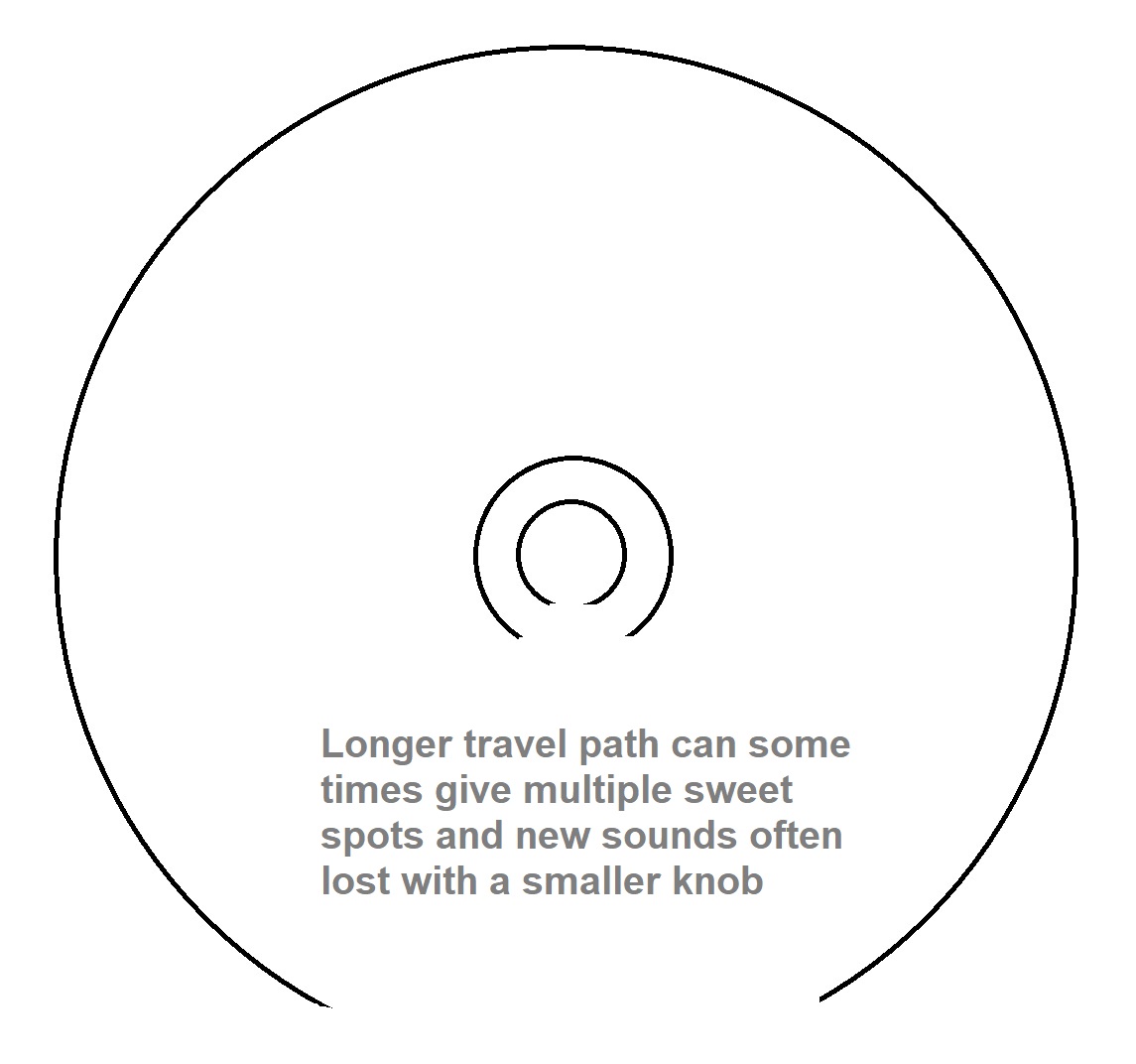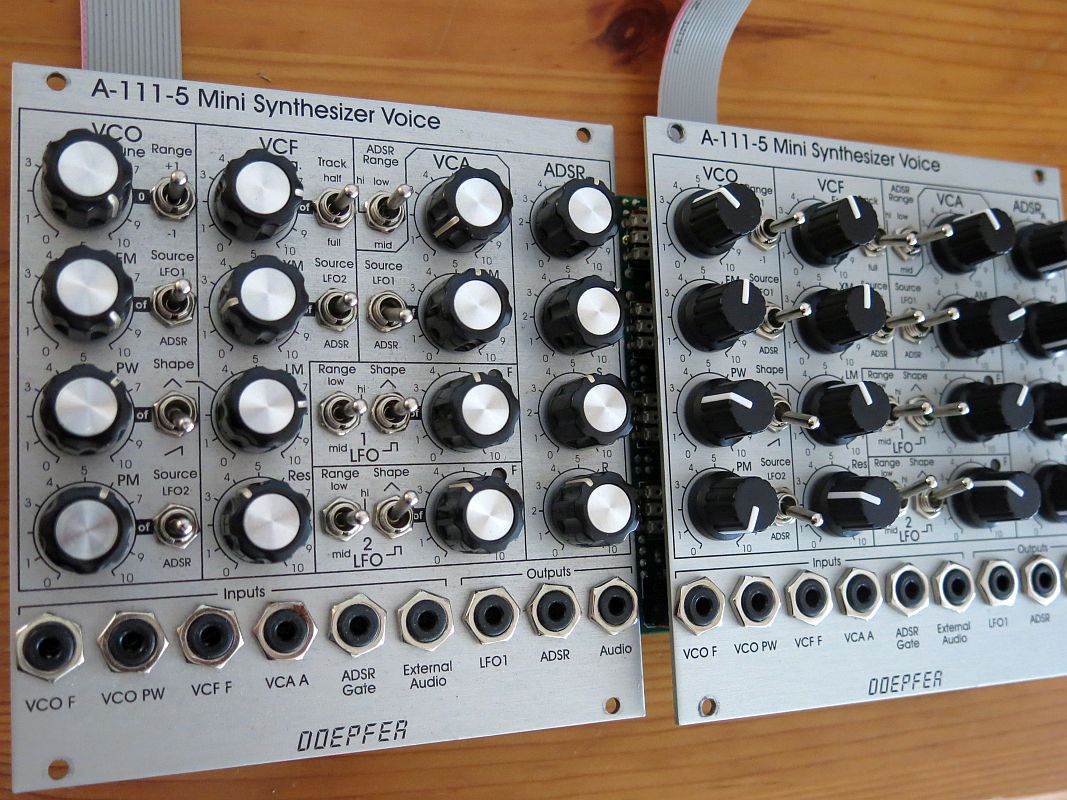Preface
A trend over some years in Eurorack have been to make modules smaller, more narrow not to waste HP (horizontal pitch). "The hunt for more modules and functions in smaller cabinets."

This comes with the obvious cost of making modules less comfortable to navigate and control. But there is another aspect of this not too often being discussed — The loss of control that comes with it — often rendering modules less useful.
How is it we lose control?
As this discussion talks about analog potentiometers maybe a better description could be loss of mechanical control. Or a even better term for this could be loss of resolution. How is this? The potentiometer after all is a rotary device with a fixed size independent of size of the knob?
The best way to describe this is to compare size of a knob to travel length of a slide potentiometer, or fader as its often called. With some exceptions of course depending on quality of resistor path and wiper size inside the potentiometer.
Resolution
As an exercise let us divide up the travel length for for an given size knob into 1024 steps. This equals 10-bit resolution typical used in ADC control scanners for many synthesizers.
A large 38mm knob will for each of the 1024 steps have a short travel length of approx 0.1mm. Now with a 6mm knob these step are narrowed down to 0.015mm.
If compared to digital resolution this is not far from going down from 10-bit to steped 7-bit which for some controls can work fine but for other not so much. Please see table for more examples.

Hunting for the Sweet Spot
Many have experienced how challeting a short 25mm fader can be when trying to set accurate LFO speed or sliding through filter resonance. Often missing the sweet spot wanted and near impossible to position the fader accurate.
A rotary pot with 6mm knurled shaft are even harder to set accurate with a pratical travel path of only 15.7mm.
While 100mm long faders on a mixing desk just feels smooth and accurate and joy to slide into position.
Similar analogy can be transferred to knob size for rotary potentiometers.
Idea for a BIG knob in a narrow panel
One could mount potentiometer similar to how an expression wheel in a synthesizer is mounted. But using a full 360° circle disc not limited to the usual half circle 2/5 turn.
Knob size and travel length
Chart show potentiometer with 300° rotational angle.
All measurement in millimeter.
| Knob Diameter |
Travel Length |
1024 Step Length |
128 Step Length |
|---|---|---|---|
| 6 | 15.7 | 0.015 | 0.122 |
| 9.6 | 25.1 | 0.023 | 0.196 |
| 12 | 31.4 | 0.031 | 0.245 |
| 16 | 41.9 | 0.041 | 0.327 |
| 18 | 47.1 | 0.046 | 0.368 |
| 20 | 52.4 | 0.051 | 0.409 |
| 32 | 83.8 | 0.082 | 0.655 |
| 38.2 | 100 | 0.097 | 0.298 |
| 50 | 130.9 | 0.127 | 1.022 |
| 100 | 261.8 | 0.255 | 2.045 |
Math used here
Circumference of a circle are found by calculate pi * diamter (πd).
Typically a rotary potentiometer have a rotational angle of 300°. This can be represented as /1.2
Travel Length = πd/1.2
3,1415926535897932384626433832795 * 10mm / 1.2 = 26.18mm

While knobs with longer circumference gives better control they also can be problematic for other reasons.
A-111-5 Mini Synthesizer's shown in photo knobs where replaced with some vintage style knobs (not Doepher original). To compare size look carefully at the silkscreen around the scale surrounding the knob. As one can see there are very little difference compared to the standard knob size used on the right side.
Sadly those vintage style knobs made this module more difficult to control. Reason being their size are uniform from top down to the bottom. Original knob size are cone shaped. Course they are much smaller at the top where finger grab one can twist the knob full turn with one fingergrip. With the vintage style knob one have to grip the knob from each side since row knob spacing are more narrow than the column spacing. Then take a new grip every 20-25° turn or so.
Comments
Your comment are welcome
KSS 2020-03-05 11:41:41 Arggh! Messed up previous description of small shaft pot tool. Take 2-3" 50-75mm of silicone or vinyl tubing which will fit snug on same length 1/4" or 6mm dowel or metal rod. Use detergent to slide the tubing over a rod so that one end has the rod exposed and the other end has the tubing. Put a big knob on the rod end. The detergent will dry and the tubing will stick to the rod. To use, push the tubing over a shaft pot, and turn the big knob at the upper end of the tool. There is enough stiffness in this arrangement to be left semi-permanently if desired.
KSS 2020-03-05 10:34:23 One tool you can make to deal with the small knobless pots is to use a silicone tubing available at hardware or home goods store, sized to fit over the end snugly, but not tight. Then use a tube over this and a large knob over the tube at the top. A couple inches length is enough. This way you can push the tube and hose over the pot shaft-knob, and turn it with greater resolution using the large knob above the tightly spaced panel..
KSS 2020-03-05 10:23:42 Well done! The A111-5 comparison is especially good. One note: While 300 degrees is the old standard for panel pots, many of the Chinese pots are now being made with 270 or even 240 degrees rotation! It makes them less expensive to make, and will not be noticed by enough users that they get away with it. Be sure to check the datasheet! I bet those skinny 'knobless' trimpot style are less than 300 degrees. Another common issue -as seen in that module- is distance or space between the knob and the toggle switch next to it. Somewhat non-intutively it can be easier to turn a knob with the switch closer than farther away. Your fingers 'roll' around the near switch where the far switch requires too much finger re-positioning, which leads to the 20-25 degree step and repeat you mention for the classic knobs. Knob height is another important size matters issue. For example, if the classic knobs were taller, the switches next to them would not interfere regardless of spacing.